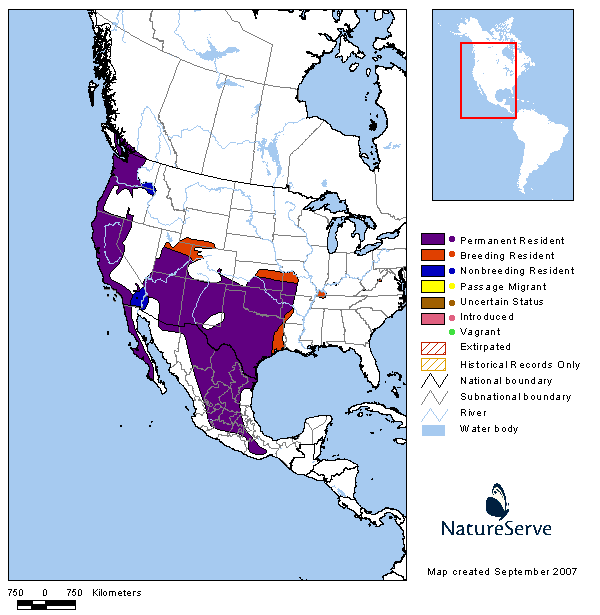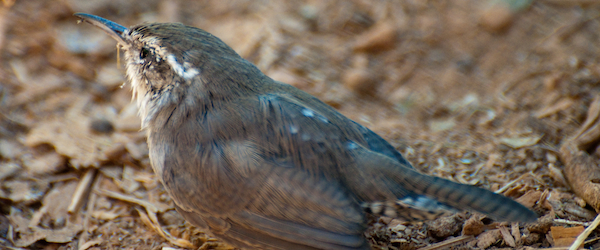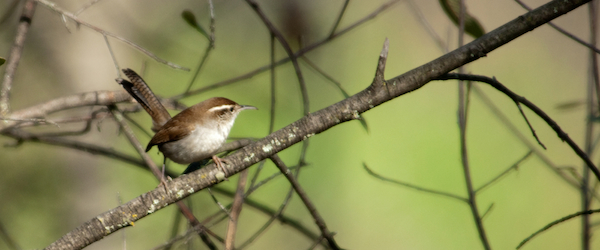A few weeks ago I was working out in the garden and noticed a small bird flutter into the garden. It was a Bewick’s Wren (Thryomanes bewickii). This bird didn’t look like the Bewick’s Wrens I was used to seeing. It was more mottled looking than others I had seen. It wasn’t very active and appeared to be molting. I believe the bird pictured above (click on photos for full sized images) is possibly a young bird going through its prejuvenal molt.
A century ago, the Bewick’s Wren was beloved as the “house wren” of the Appalachians and the Midwest. Today, the species has all but disappeared east of the Mississippi River and has declined in western parts of its range, most likely caused by the expansion of the House Wren which destroys and removes their eggs from nest sites1.

This is what I am used to seeing. In the Spring, when the male Bewick’s Wren sings to establish a territory. You can hear his cheerful song here.
A brighter, more cinnamon color and a more distinct white eyebrow.
I don’t know. Maybe this is simply a molting adult? What do you think?
Here’s a shot of him under the zucchini plants picking aphids off the leaves.
And finally, a view of the springtime Bewick’s Wren at the end of his photo shoot!
References: 1Birds of North America Online




















There used to be a pair outside my office window when I worked for the Point Reyes Bird Observatory in California. I always enjoyed watching them.
Wonderful shots of this adorable little wren!
Wonderful shots of this adorable little wren, Larry!
Larry et al,
I got the pleasure of holding a Bewick’s Wren after it hit a window. It recovered quickly but was very trusting while it did so. Here are my pics of it . . .
http://www.flickr.com/search/?w=83861409@N00&q=bewick's%20wren
Enjoy!
Liza
@Duncan I didn’t know that you at one time worked for the PRBO! What a wonderful group of people that organization is blessed with and they do such good work.
What a great little bird – and so nice of it to clean up your aphid problem!
Stewart M – Australia
Larry, Since you are on the west coast, you are not dealing with the nominate race. Even here in the midwest, Bewick’s are in deep trouble. The entire east coast & Appalachian population is gone. Tennessee and Kentucky had 2 pairs found after intensive searches, both associated with junkyards. Missouri is the last “stronghold” of the eastern population.
The grayer race, in the interior, is doing well it seems and since your photo is of the reddish colored wsat coast population hopefully they are doing well also.
Thanks for a nice article!
Tim
The differences you describe are just in general colouration and not in a distinct pattern or structure. Therefore, they are very difficult to assess and might very well be caused by wear, bleaching, illness, or moult. That’s just a general remark as I have only ever seen one Bewick’s Wren and am in no position to go even a tiny step further than that.
Looking at your map makes me realize again just how lucky I was to find my one and only Bewick’s just west of St. Louis. Phew!!
For what it is worth:
In Tennessee, I saw 4 singing males in one day in late Apr 2010 (Murfreesboro area). One bird had a mate, which apparently went missing according the home owner/farmer, but they had an abandoned nest in a very fancy workshop. Another bird never sang, but had a mate (and both would come in silently to a little playback). The other 2 males were likely unmated since they wandered around and sang continuously. We only had 2 singing males this year, but one was in a “new” location.
In some places, they are associated with trailers and several out buildings. However, one location where we’ve had a bird for a couple years is actually around a couple well maintained homes with gardens. The bird at this spot is one of the birds we think is unmated. The owners need to put up some sheds, fill them with junk, and leave the door open!
Gallery with photos of the TN birds from 2010 is here.
http://www.pbase.com/shoeman/bewr
@Timothy thanks for the input. Luckily ours seem to be doing well here out West. I am curious about the most likely cause of their demise is the growing population of House Wrens. Do you see an abundance of House Wrens in the Mid-west and East? Apparently there are 16 subspecies of Bewick’s Wren recognized by the AOU and 3 in Mexico
@Jochen excellent points. It is also possible that there are two subspecies that travel through central California
@Scott this is good news. As with Bluebirds, it is possible that a nest box program in areas without House Wrens would help the Bewick’s Wren. Obviously, you wouldn’t want to let House Wrens breed in the boxes.
Larry,
The birds we know about have used old plastic milk cartons with the front cut off or (like the nest we had in 201) it was in a workshop in a narrow shelf, buried in the back. I don’t know if boxes would work or not. We might try a Buick’s for Bewick’s conservation program for private land owners. Pay folks to put up trashy garages and barns (with shelving) and get old cars (leave the windows open) for the birds 🙂 Ok, maybe not, but….
Scott, This is typical for the birds in the Ozarks too. Junkyard dogs! 🙂
Hey I am going to be totally focused on filming as many of these guys as i can next spring. they should be back early so if these cats are up there again-please let me know. I’ll be working several BBS routes in the northern Ozarks where they are still present. Arkansas is basically gone too. To the west the intergrades begin in central eastern Kansas. They are a touch redder than further west in the state. I looked at a large series of specimens to get a sense of some birds in the north end of the Flint Hills not too far from Topeka. The footage I shot did not show a ton of red nor in the field. The specimens matched up. The footage also shows a bunch of white spotting in the lower back which is not illustrated , it appears this is a molt character.
I’ve been working a bit in Indiana and will try to get into the Cumberland Plateau for a bunch next year. What part of Tennessee are you in?
Tim
Choteau, MT
Scott – Also wanted to make sure you had read the Michael E. Hodge and Gary Ritchison paper in Kentucky Warbler.
Tim
Thanks Tim.
Tim,
I’m in Nashville. The few bird we have left are in the Murfreesboro area, just a little SE of Nashville.
Scott- how are the Bewick’s Wrens last year in your area? I’m going to try to spend a lot of time in my van this year traveling filming and speaking on conservation subjects.
tim
For the past month, we’ve had a very busy, very friendly beswick wren using a bowl on our patio for insect hoarding. Then I noticed another helping her. Then there were 3 the other morning, real early. Then one came over to me, real close and chastised me with alot of chirps. And boom, just like that.. They are gone. And I dont know why?? No sign of them anywhere. Do they migrate out of CA in April? It just got real warm here. Or did i chase them off on accident? I really miss them. They were so cute & entertaining. Anyway, I cant find any info on why, so I thought I’d ask here. Thank you